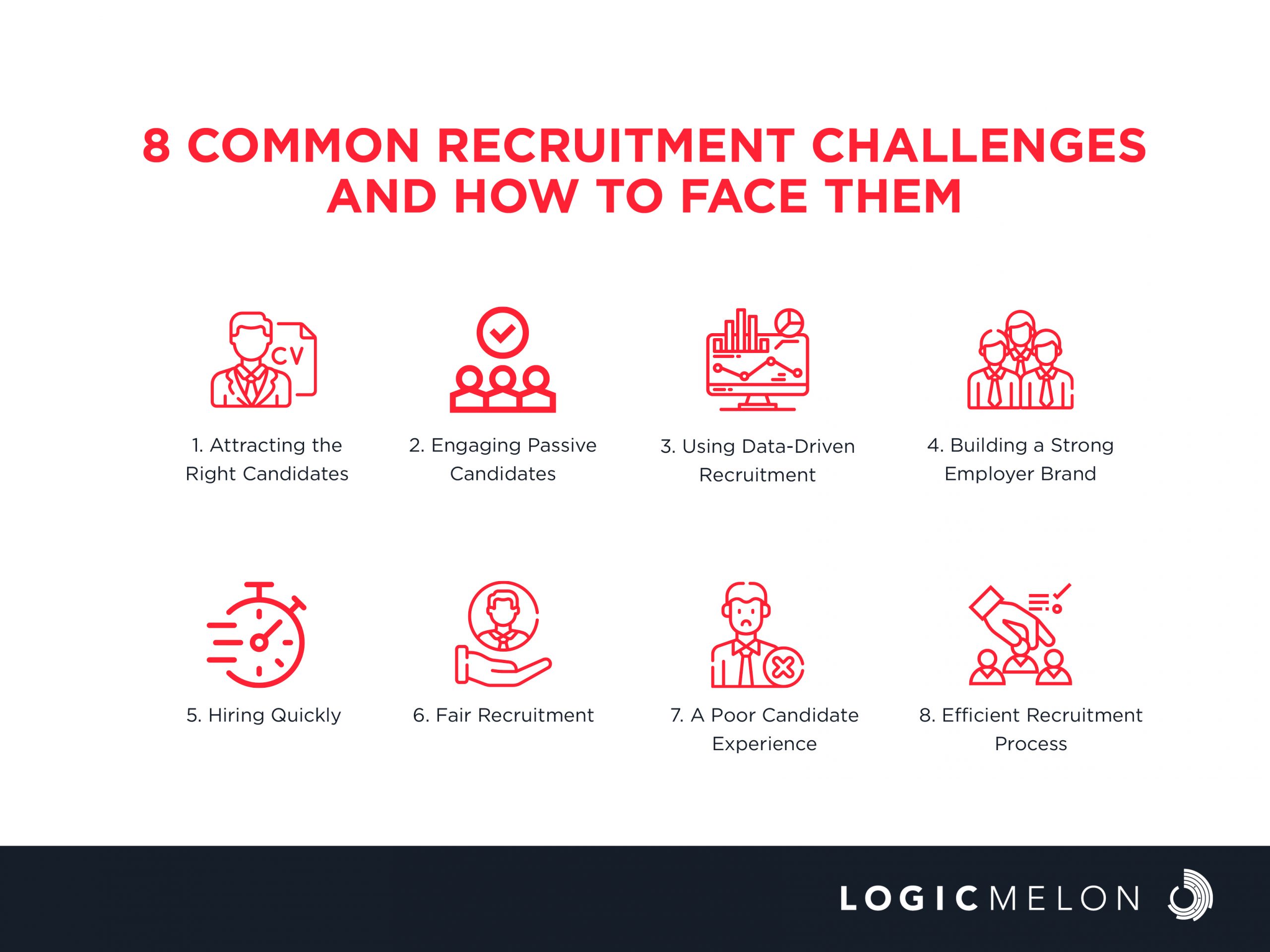8 Common Recruitment Challenges and How to Face Them
Recruitment has always been a challenging task. When you indulge in frequent hiring for your organisation, you are bound to face these challenges. It is necessary to understand the challenges in recruitment and ways to handle them for a smoother hiring process.
You will likely face some specific recruitment challenges based on the company’s size. From attracting top talents to retaining candidates in your talent pool, a recruiter might face plenty of challenges.
You need to understand the following recruitment challenges to continue your recruitment process smoothly.

1. Attracting the Right Candidates
When you start searching for a candidate for your open roles, or post a job opening on various channels, you might find that the candidates who apply might not be suitable for your job.
Sometimes, you might need to choose a candidate who is the most qualified among the available candidates.
This affects your quality of hire. If that is the case, you may settle for a candidate not wholly qualified to take the role and responsibilities.
Even if a good number of candidates apply for your job role, it will not help you if most of them are unqualified for your job.
For instances like this, you should look into your job descriptions and tweak them so only qualified candidates apply.
Alternatively, you can add knock-out questions in your application so that many candidates are shortlisted.
2. Engaging Passive Candidates
Passive candidates are necessary for your recruitment. Not only are they qualified for your job opening, but since they are, it does not take much time to bring them into the workforce once they show interest in your job offer.
The recruitment challenge here is that they are in high demand, and hence they are sought out by many recruiters.
In such cases, you must stand out and keep the candidate engaged with your communication.
Since these candidates have the necessary experience, they will contribute significantly to your company once they join the workforce.
Bringing in passive candidates can give you an edge over your competitors.
3. Using Data-Driven Recruitment
To constantly improve your recruitment efforts, you need to monitor your hiring process and keep track of the metrics that can help you improve the process in the future.
Using a spreadsheet and manually calculating the metrics may not help you in the long run. It is an intensive process and takes a lot of time.
Employing data-driven recruitment methods need to be prioritised. The hiring team should focus on improving the recruitment process to ensure that none of their efforts are wasted.
Since manual work is prone to human error, you need to keep track of the data using an ATS that can help you provide valuable insight to help with your recruitment.
4. Building a Strong Employer Brand
Attracting candidates is the first step in recruitment. You need to get the word out about your jobs, create job postings on various channels, and attract the top talent.
Attracting candidates could be easier if you already have a good employer brand to bank on.
Candidates are more likely to apply for a company with a good reputation.
You must promote your culture, ensure that your candidates have a positive experience, take care of the employee wellbeing and development, and have a diverse working culture.
Employers should constantly repeat all this to build a reputation for their company. While this is not a quick process, it is necessary nonetheless.
5. Hiring Quickly
The longer you leave a position vacant, the more money you lose. Likewise, the longer you take to hire for an open position, the more money it costs you.
Not to mention, you need to shortlist qualified candidates and bring in top talent for your workforce while competing with other company workforces.
Sometimes, you might have a lengthy hiring process that results in the candidate becoming disinterested in the job entirely.
The recruitment process might take a long time due to the shortage of candidates.
Regardless of the reasons, hiring as quickly as possible could help you bring in the best candidates and reduce the cost of filling vacancies.
6. Fair Recruitment
Handling unconscious bias in recruitment is always a challenge. This can make it hard for you to look at the candidates objectively.
When you let bias creep in, you risk losing qualified candidates. Also, you risk indulging candidates who make the company culture stagnant.
To bring in diverse employees, you need to have a recruitment process that helps you bring in candidates from various cultural backgrounds.
It is also necessary to ensure that none of your selection criteria rejects candidates based on gender, race, and religion.
7. A Poor Candidate Experience
How the candidate feels during recruitment goes a long way in building a reputation for your brand.
The candidate is most likely to accept your job offer if they had a positive candidate experience.
The experience you provide your candidates will help attract more candidates, which can help you in future recruitment.
Communicating with the candidate can help you in many ways. The candidate feels more comfortable with the entire recruitment process.
8. Efficient Recruitment Process
A recruitment process should ensure that everyone in your hiring team communicates effectively. This helps you to complete the recruitment stages quickly.
If the communication takes time, the candidate can be left waiting, which can contribute to a negative candidate experience.
You cannot afford to keep the candidate waiting and prolong the recruitment process due to inefficient hiring.
Tips to Overcome Recruitment Challenges
The following are some of the tips to overcome recruitment challenges:
- The best way to ensure that only qualified candidates apply for your job openings is by making your job posting clear and concise. Once the candidate understands the requirements for the job, you are less likely to have unqualified candidates fill out the application form.
- When contacting passive candidates, take some time to understand and customise your message for each passive candidate. This will make them interested in your offer, and help to better engage them.
- To make your hiring process more efficient, look into your recruitment metrics and find ways to optimise them. Tracking the recruitment metrics can help you constantly improve your recruitment process.
- The recruitment process usually consists of multiple stages. Take a look into each stage and trim down the steps that seem redundant. This can significantly speed up your hiring process and offer the candidate a better experience.
- Each role should require candidates with a different skill set to handle their duties effectively. This significantly affects your time to fill the position. It is always good practice to set realistic expectations for the time it takes to fill the role.
- Use an ATS for your recruitment process. It has many benefits, such as data analytics that offer valuable insights, automated communication with the talent pool, advanced candidate search, and many other features that can help you in every stage of recruiting.
- To build a good employer brand, look into how you could improve the employees’ work life. Try to address their concerns and give them the space to talk about the company experiences.
- To offer a positive candidate experience, communicate with them promptly, and set expectations when they can expect a reply. Send personalised messages to keep them engaged.
- To ensure that you recruit fairly and assess every candidate equally. You could try using blind recruitment and structured interview methods.
- For a team to recruit efficiently, try using an ATS to collaborate with the hiring manager and everyone in the interview panel to assess the candidate fairly and communicate easily with each other.
- Regardless of the company size, if you engage in recruitment regularly, you can benefit significantly from a talent pool. This can help you with hiring candidates quickly, as well as help you in future recruitment needs.
- Follow regulations, like GDPR, when processing and storing candidates’ information.
- Train your recruitment team to handle and engage candidates throughout the recruitment funnel. Also, educate them about bias that might come in when recruiting. This will help to build awareness of unconscious bias.
- Come up with ways to include diverse hiring methods into your existing recruitment process. Including diverse hiring practices is the first step in building a diverse workforce.
Frequently Asked Questions
1. What are some common recruitment challenges?
The following are some recruitment challenges that every employer faces:
- Attracting the right candidates.
- Engaging passive candidates.
- Using data-driven recruitment.
- Building a strong employer brand.
- Quick hiring.
- Recruiting fairly.
- Offering a good candidate experience.
- Creating an efficient recruitment process.
2. How do we overcome the challenge of diversifying the workforce?
To include a diverse workforce, you must ensure that the recruitment process is conducted fairly. Implementing structured interviews and engaging in blind recruitment can help you alleviate bias and bring in diverse employees for your workforce.
3. Why do we need to address recruitment challenges?
For every business, recruitment plays a considerable role. It can improve your branding and help you attract more candidates to enhance your business. Challenges in recruitment make it hard for you to attract top talent and needlessly expand your resources. To avoid this, you need to address the challenges you face in recruitment.
Final Thoughts
Handing all the recruitment challenges can become a daunting task. The first step is to take it easy, understand your challenges, and prioritise them based on which ones need immediate attention. Identify ways to change your recruitment style to address the problem at hand.
LogicMelon
Award-winning recruitment software that will find, attract, hire and analyse the way you want to work. At LogicMelon, we have experienced software recruitment marketing specialists to help you build effective recruitment solutions supported by the best customer service you’ll find anywhere!
Email: [email protected] or call LogicMelon (UK) +44 (0) 203 553 3667 (USA) +1 860 269 3089
Recruitment Crisis Management
Recruitment crisis management requires adaptability, strategic thinking, and a proactive approach to address talent shortages and avoid disruptions.
Candidate Matching: Everything You Must Know
To successfully implement an ATS, it is important to consider certain factors. Learn more by reading this blog.
Streamlining Recruitment: ATS Implementation Best Practices
To successfully implement an ATS, it is important to consider certain factors. Learn more by reading this blog.


